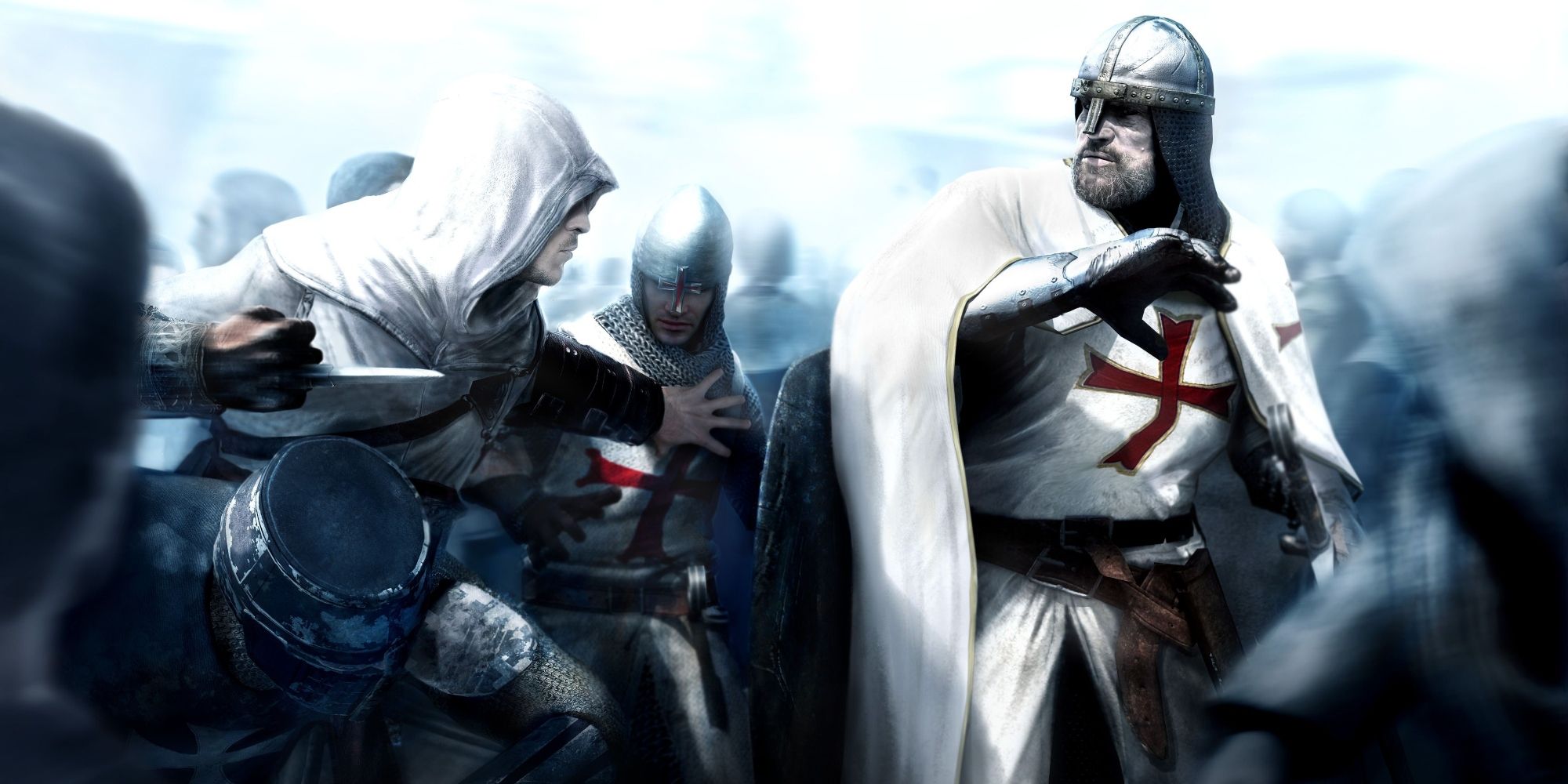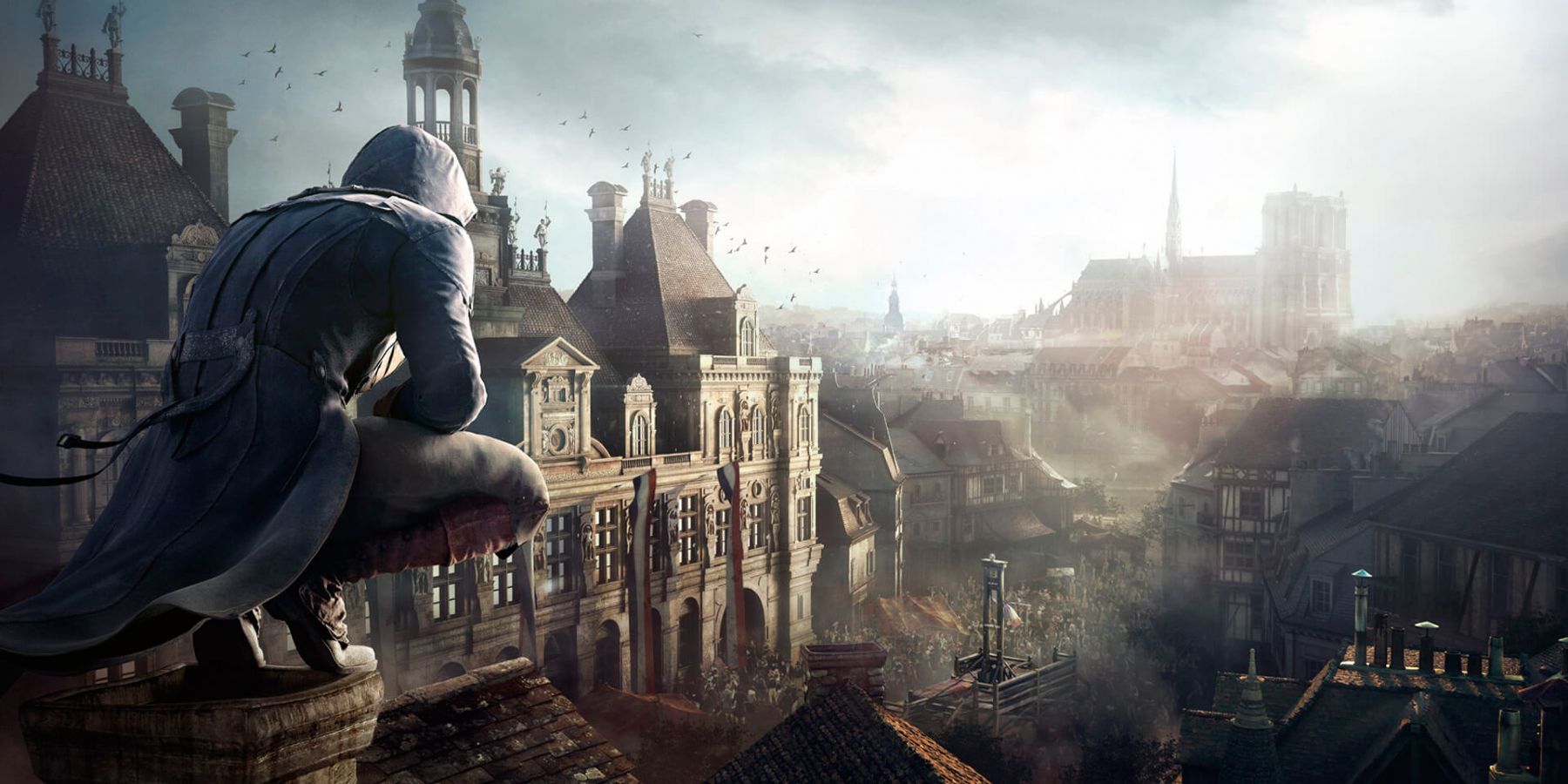The Assassin’s Creed series is inextricably linked to the iconic weapon used by members of the Assassin Brotherhood, the Hidden Blade. Typically attached to the underside of the left wrist, Assassins throughout history employ the hidden blade for numerous reasons, but mainly as a stealthy, effective means of eliminating high profile targets. When not in use, the blade retracts inside of its casing – usually some form of bracer. Though once a marvel piece of technology, throughout the centuries of its use, the Hidden Blade has gone through many iterations, with multiple upgrades serving a range of purposes.
The first use of a Hidden Blade is depicted in a cutscene in the Assassin’s Creed Odyssey episodic DLC, Legacy of the First Blade. A man named Darius, an early opposer to the Order of the Ancients – the forerunners of the Templars – used a Hidden Blade of his own design to assassinate the Persian tyrant King Xerxes I. Darius’ Hidden Blade was eventually passed down through the centuries to his descendant Aya, who – along with her husband, the protagonist of Origins, Bayek of Siwa – founded the Hidden Ones in order to organize against the Order of the Ancients in the Ptolemaic Kingdom in Egypt.
Bayek chose to wear the Hidden Blade on the underside of his arm, opposite of how Darius is shown to use it in Odyssey. This results in Bayek accidentally severing his ring finger during a fight, starting the tradition of Assassins cutting off their fingers in order to utilize the weapon. The Hidden Ones slowly gave way to the Assassin Brotherhood over the centuries, and the Hidden Blade became a staple of the Assassins’ arsenal.
Altaïr’s Upgrades To Assassin’s Creed’s Hidden Blade

In the year 1191, when the first Assassin’s Creed takes place, the Hidden Blade remains largely unchanged from its ancient design. It is a retractable blade, typically worn on the inside of the wrist, that requires the removal of the ring finger. This amputation is also a symbol of dedication to the Brotherhood (and the Hidden Ones before), as Hytham tells Eivor when they receive the Hidden Blade in Assassin’s Creed Valhalla. Eivor, however, opts to wear the Hidden Blade on the outside of their arm – much like Darius – in order to avoid the amputation.
Modifying the Hidden Blade so that it doesn’t require an amputation was one of the first upgrades made to the weapon by the legendary master Assassin Altaïr. Inspired by the Apple of Eden he wins from his former mentor, Al Mualim, Altaïr made many advancements to the Hidden Blade’s design, which he then codified in his codex. The codex pages were later found by Ezio in Renaissance Italy, and are the in-universe explanation for the upgrades granted throughout Assassin’s Creed II.
One upgrade was attributed to Altaïr in order to explain the change in combat mechanics between the games which allowed for the Hidden Blade to be used in open combat. Altaïr made the Hidden Blade’s design more robust, adding armor plating to the outside of the arm so that it can be used to deflect incoming attacks. The most obvious upgrade on the original Hidden Blade design – simply adding a second to the user’s other arm – was also attributed to Altaïr.
Upgrades To The Hidden Blade For Ezio

Though Altaïr is canonically responsible for many more upgrades to the Hidden Blade, some of his more specific modifications used in later games were products of Assassin’s Creed II‘s prominent historical figure, Renaissance man Leonardo da Vinci. These included the Poison Blade, where a Hidden Blade was hollowed and filled with poison. The Poison Blade had the added benefit of being even more inconspicuous than a Hidden Blade, since the delayed effects of the poison allowed the user to leave the vicinity before the victim succumbed. The poison would also send the target into a rage, attacking other enemies and creating a distraction.
Da Vinci also constructed Altaïr’s Hidden Gun for Ezio, which allowed him to eliminate targets at range, albeit in a much more conspicuous manner. In Assassin’s Creed Brotherhood, da Vinci would combine the Poison Blade and the Hidden Gun to produce the Poison Dart Launcher. This allowed Assassin’s Creed’s Ezio to eliminate targets from range quietly, with the added effects of the poison.
When Ezio arrived in Constantinople during the events of Assassin’s Creed Revelations, he was given a Hookblade, an invention of the Ottoman Brotherhood. The Hookblade has a variety of uses, which include allowing Ezio to ride zip lines throughout the city and pulling enemies to the ground in combat.
Other Historical Hidden Blade Modifications

As the Assassin’s Creed series’ timeline progressed, so did the Hidden Blade. Master Assassin Ratonhnhaké:ton, also known as Connor Kenway, made great use of the Pivot Blade during his time in the Colonial Brotherhood in revolutionary America. In addition to being usable in the traditional manner, a hinge allows the Pivot Blade to rotate in order to be wielded like a dagger. Assassin’s Creed 3‘s greater emphasis on wildlife locations was bolstered by the Pivot Blade having a serrated edge, making it easier for Connor to skin animals.
Assassin’s Creed Unity introduced an evolution of da Vinci’s Poison Dart Launcher – the Phantom Blade. The Parisian Brotherhood commonly used the weapon, which was essentially a miniaturized, wrist-mounted crossbow. Instead of firing bolts, the Phantom Blade silently launches blades, allowing Unity protagonist Arno Dorian to assassinate targets from a distance while remaining hidden.
The side-scrolling, 2.5D Assassin’s Creed Chronicles games brought two interesting modifications to the Hidden Blade. One was known as the Hidden Footblade, which extended out of the user’s shoe. The Footblade was used by Chinese Assassin Shao Jun in areas where weapons were confiscated upon entry. Another Hidden Blade upgrade in Chronicles was the Trident Blade. Indian Assassin Arbaaz Mir was known to use the Trident Blade, which could extend from the wrist into a three-bladed weapon. It seems the only benefit to the Trident Blade was to deliver three stab wounds instead of one.
Modern Modifications To The Hidden Blade

Though the advent of firearms in Assassin’s Creed largely made the Hidden Blade obsolete, modern Assassins still use the legendary weapon in special circumstances, and even have some new upgrades. For example, at the end of Assassin’s Creed Syndicate, Shaun Hastings is shown to wield an electrified Hidden Blade known as the Shock Blade. The Shock Blade employs two parallel blades in order to deliver its electricity, which appears to have been inspired by a similar, two-bladed Hidden Blade used by a 15th century Spanish Assassin in the 2016 Assassin’s Creed movie.
The Assassin’s Creed movie also introduced another modern Hidden Blade upgrade. The Composite Blade was designed to look like a variety of everyday objects when dismantled, that way it could be taken through security checkpoints inconspicuously and reassembled. This might be an interesting addition to the game series if it ever opted to set a title completely in its modern day setting.
The Assassin’s Creed series owes much of its identity to the Hidden Blade and its continued evolution. Just as the series was begun with Master Assassin Altaïr, so too was the tradition of upgrading the Hidden Blade. While the need for fresh game mechanics demanded new gameplay options for the Hidden Blade, it is partly the deep lore of Assassin’s Creed that gives the iconic weapon an interesting history.




